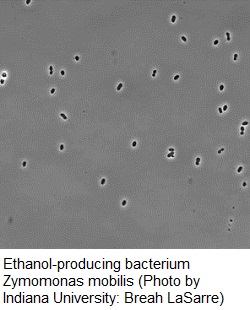 Researchers at the University of Indiana might have come upon a way to partner bacterium with nitrogen gas to make more ethanol. This news release from the school says biologists there have found a faster, cheaper and cleaner way to increase ethanol production by using nitrogen gas, the most abundant gas in Earth’s atmosphere. The discovery could help make cellulosic ethanol more competitive with corn-based ethanol.
Researchers at the University of Indiana might have come upon a way to partner bacterium with nitrogen gas to make more ethanol. This news release from the school says biologists there have found a faster, cheaper and cleaner way to increase ethanol production by using nitrogen gas, the most abundant gas in Earth’s atmosphere. The discovery could help make cellulosic ethanol more competitive with corn-based ethanol.
The raw materials for cellulosic ethanol are low in nitrogen, a nutrient required for ethanol-producing microbes to grow, so cellulosic ethanol producers are estimated to spend millions of dollars annually on nitrogen fertilizers like corn steep liquor and diammonium phosphate. But an IU team led by biologist James B. McKinlay has found that the bioethanol-producing bacterium Zymomonas mobilis can use nitrogen gas (N2) as a nitrogen source, something that the more traditional ethanol-producer, baker’s yeast, cannot do.
“When we discovered that Z. mobilis could use N2 we expected that it would make less ethanol. N2 utilization and ethanol production demand similar resources within the bacterial cell so we expected resources to be pulled away from ethanol production to allow the bacteria to grow with N2,” McKinlay said. “To our surprise the ethanol yield was unchanged when the bacteria used N2. In fact, under certain conditions, the bacteria converted sugars to ethanol much faster when they were fed N2.”
Knowing the bacterium could use N2 without hindering ethanol production, the team reasoned that N2 gas could serve as an inexpensive substitute for nitrogen fertilizers during cellulosic ethanol production.
“Until recently, ethanol has been produced almost entirely from food crops, but last year there was a surge in cellulosic ethanol production as several commercial facilities opened,” McKinlay said. “Cellulosic ethanol offers more favorable land use and lower carbon emissions than conventional ethanol production. Even so, cellulosic ethanol is struggling to be cost-competitive against corn ethanol and gasoline.”
The researchers believe N2 gas, which can be produced on-site at production facilities, could save an ethanol production facility more than $1 million dollars a year. They have filed for a provisional patent on the idea.

